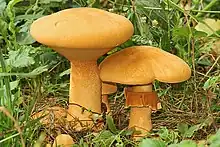Squamanitaceae
The Squamanitaceae are a family of fungi in the order Agaricales. All species in the family are agarics (gilled mushrooms). Species in two genera, Dissoderma and Squamanita, are parasitic on other agarics. Members of the Squamanitaceae are found worldwide.
| Squamanitaceae | |
|---|---|
_Fayod_374647.jpg.webp) | |
| Cystoderma amianthinum | |
| Scientific classification | |
| Domain: | Eukaryota |
| Kingdom: | Fungi |
| Division: | Basidiomycota |
| Class: | Agaricomycetes |
| Order: | Agaricales |
| Family: | Squamanitaceae Jülich (1981) |
| Type genus | |
| Squamanita Imbach (1946) | |
| Genera | |
|
Cystoderma | |
| Synonyms | |
| |
Taxonomy
The family was first proposed in 1981 by Dutch mycologist Walter Jülich. Its current circumscription is the result of molecular research, based on cladistic analysis of DNA sequences.[1][2]

_O.K._Mill.%252C_T.J._Volk_%2526_Bessette_823455.jpg.webp)

 Squamanita umbonata
Squamanita umbonata
References
- Liu JW, Ge ZW, Horak E, Vizzini A, Halling RE, Pan CL, Yang ZL (2021). "Squamanitaceae and three new species of Squamanita parasitic on Amanita basidiomes". IMA Fungus. 12 (1). doi:10.1186/s43008-021-00057-z. PMC 7927255.
- Saar I, Thorn RG, Nagasawa E, Henkel TW, Cooper JA (2022). "A phylogenetic overview of Squamanita, with descriptions of nine new species and four new combinations". Mycologia. 114 (4): 769–797. doi:10.1080/00275514.2022.2059639.
This article is issued from Wikipedia. The text is licensed under Creative Commons - Attribution - Sharealike. Additional terms may apply for the media files.